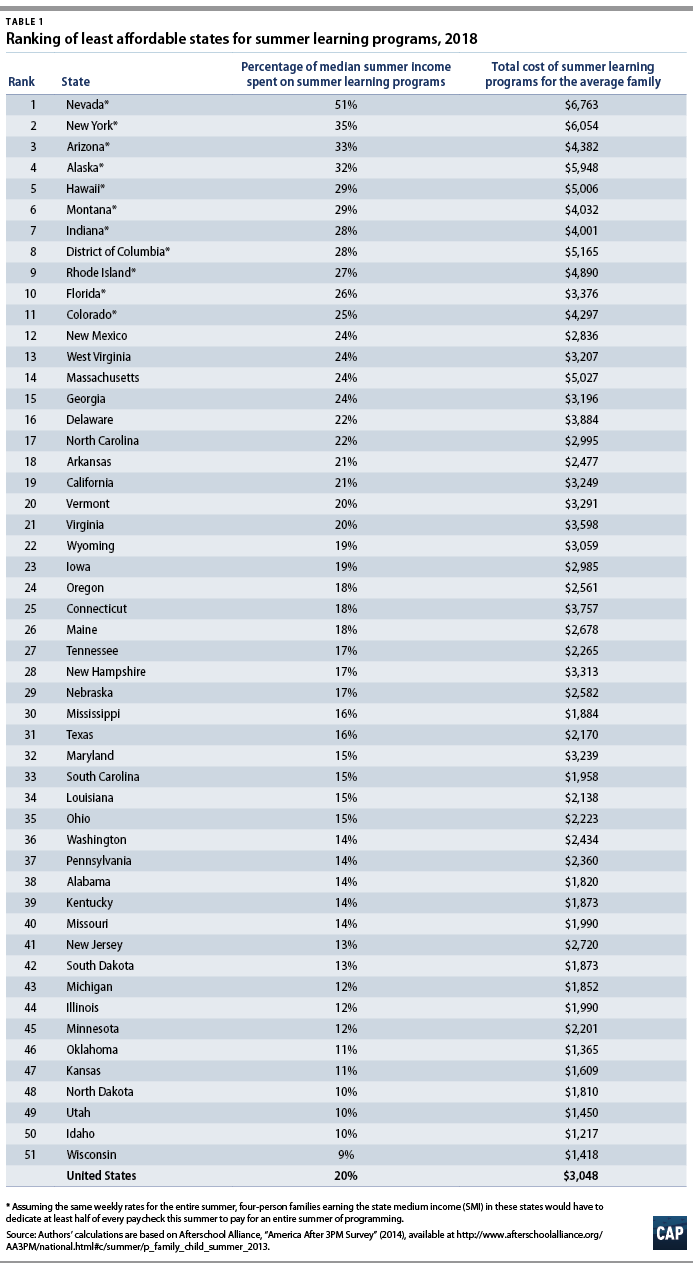As schools start to close for summer, working parents face a deceptively tough question: Who will care for their children over the summer? Parents want their children to be happy and healthy during the 10 to 12 weeks that school is out of session, but with the high costs of child care, many working parents struggle to ensure this is the case.
At a time when 2 out of 3 children have all available parents in the workforce, high-quality child care is a year-round necessity. For families with young children, reliable and affordable child care is hard to find—no matter what month it is. But for parents of school-age children, summer can be especially challenging. Most parents still work during the summer, and few can afford to take time off. Indeed, nearly 40 percent of all workers lack any paid vacation time.
The typical school day rarely reflects parents’ work schedules, meaning that families often pay for before- and after-school care and sometimes care during night and weekend shifts as well. Summer break leaves an even more significant gap between children’s and parents’ schedules. Parents who work are left scrambling to find arrangements that will keep children safe, engaged, and learning during the long summer months. These arrangements often have expensive price tags, forcing difficult tradeoffs between necessities—such as food, clothing, and shelter—and summer child care that keeps children safe.
Despite the high price of summer programs, families’ needs are not fully met
To fully understand the financial impact summer care has on families, the Center for American Progress analyzed data from the Afterschool Alliance’s America After 3PM survey. This analysis estimates that the average family will spend more than $3,000 on summer programs for two children, representing 20 percent of a typical family’s income for the entire summer.
The costs and affordability range from state to state and from city to city. According to CAP’s estimate, Wisconsin has the most affordable summer programs: A family of four earning the state median income can expect to pay just more than $1,400 for summer care for two children. That amounts to 9 percent of the income the parents will earn during the summer months. Nevada—where the same family can expect to spend more than $6,700 on summer child care—has the least affordable options.* As a result, a family earning the median income in Nevada would need to spend more than half the income earned during the summer months for their children to attend summer child care programs.

Although these costs represent a significant share of the typical family’s budget for the summer—they exceed the U.S. Department of Health and Human Services’ child care affordability threshold of 7 percent in all states—they only cover care for about half of the summer. On average, children receive just five weeks of summer programming, even though most schools close for 10–12 weeks; this leaves parents to scramble to put together a patchwork of care for the rest of the summer. To pay for 10 weeks of summer programming at the same rates, families earning the median state income in 10 states and the District of Columbia would have to dedicate at least half of every paycheck this summer to paying for care.**
Unfortunately, many parents cannot afford to enroll children in these programs for even part of the summer. In fact, a recent study showed that nearly half of parents reported difficulty affording summer care. To secure care, they must cobble together care from family members or friends, coordinate multiple programs with different hours and requirements, or occasionally leave children unsupervised. As a result, the number of children without regular child care arrangements increases during the summer. In fact, data from the Survey of Income and Program Population show that, among preschoolers with working mothers, the share of children without regular child care increased nearly four-fold from spring 2005 to summer 2006—from 11 percent to 42 percent. For grade school-aged children with working mothers, the increase was more modest but still significant—37 percent to 49 percent.
For children in lower-income families, a lack of high-quality care can significantly affect their academic success. Research shows that most children lose important math skills during the summer, regardless of family income. But lower-income students—who are also disproportionately children of color and English language learners—also lose reading skills and never gain them back. Researchers believe this so-called summer slide accounts for about half of the overall achievement gap between lower- and higher-income students. And although high-quality summer learning programs help close these gaps, they are of little help if families cannot afford them.
Families need affordable, high-quality child care all year
Summer—supposedly a season of long, carefree days—is anything but relaxing for today’s working parents. For too many families, securing reliable summer care is a financial and logistical challenge. The Child Care for Working Families Act—introduced by Sen. Patty Murray (D-WA) and Rep. Bobby Scott (D-VA)—would help address this challenge. This bill would guarantee child care assistance for low-income and middle-class families with children under age 13 and ensure that no one pays more than 7 percent of their income for child care. It puts high-quality, affordable child care within reach for families all year long, including the summer months. Providing parents with affordable, year-round options would help parents maintain their jobs and create more stability for children. The nation’s families deserve as much.
Cristina Novoa is a policy analyst for Early Childhood Policy at the Center for American Progress.
For more information about the methodology used in this analysis, read the author’s Methodology Memo here.
*Author’s note: The author calculates affordability by dividing the average cost of care by the state’s median income. Child Care Aware of America’s annual “Parents and the High Cost of Child Care” report has utilized this approach for more than a decade. For more detail, see Methodology Memo.
**Author’s note: These states are Nevada, New York, Arizona, Alaska, Hawaii, Montana, Indiana, Rhode Island, Florida, and Colorado. See Methodology Memo for additional information.